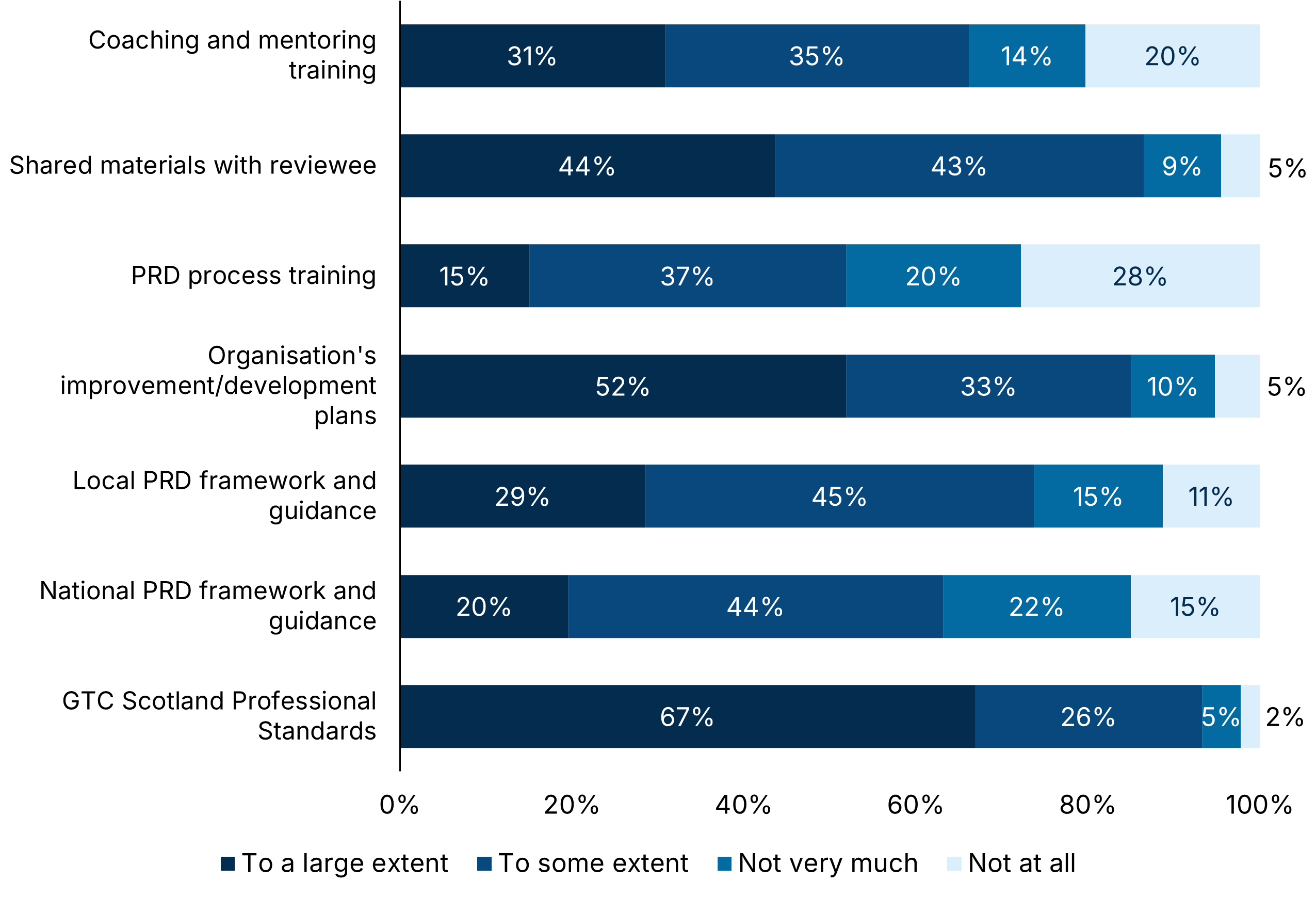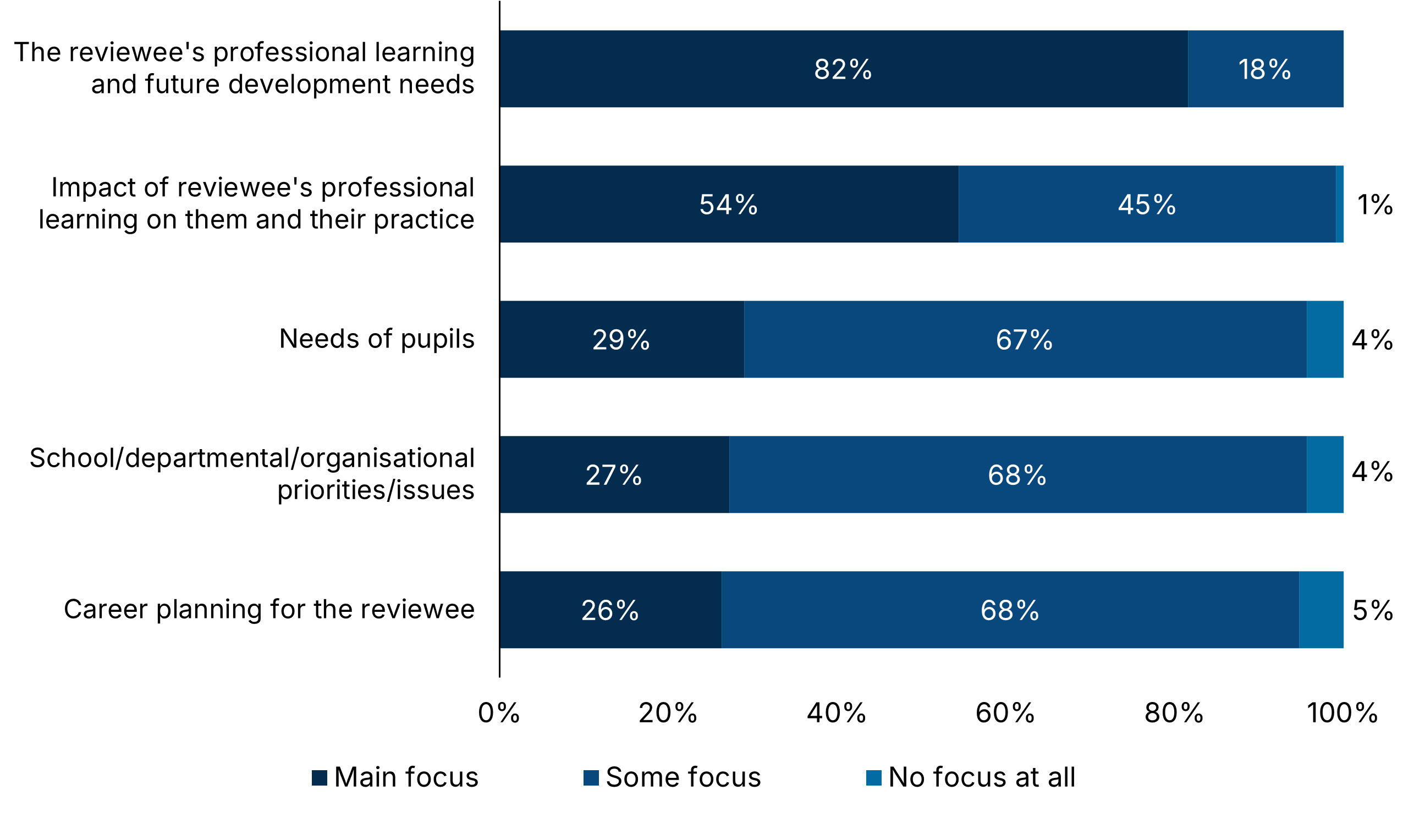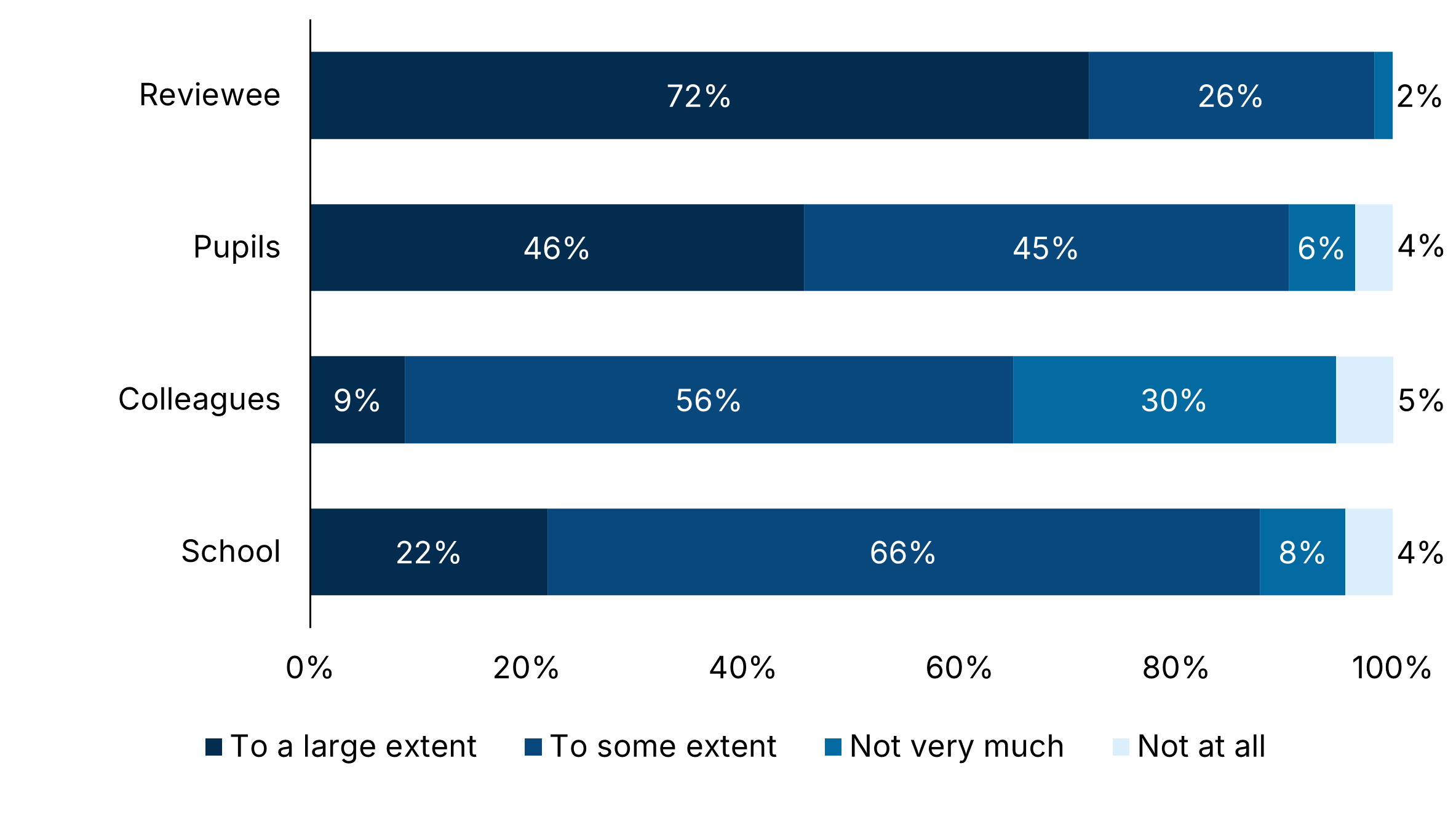Reviewers
Knowledge and information
Of 133 reviewers who answered the question, 77% felt that the information, briefings and support they were given were helpful to a large extent or to some extent in preparing them for their role as a line manager or reviewer in the Professional Update process.
When asked ‘To what extent, if any, did you use/engage in the following to prepare for the PRD meeting with your reviewee(s)?’ Graph 23 (n=133) shows that 93% used the Professional Standards to a large extent or to some extent, 87% shared materials with their reviewee(s) and 85% used their organisation’s improvement/development plans.
<span id="es-chart-01" class="table_caption" style="text-align:center; margin: auto; display: block; padding-top: 3.5rem">Graph 23: To what extent, if any, did you use/engage in thefollowing to prepare for the PRD meeting with your reviewee(s)?</span>

Reviewers were asked if they had had training in coaching and mentoring approaches. Responses are shown in graph 24 (n=133) and responses were mixed with 31% saying they had not had training and 31% also declaring themselves as not confident in this area, although it should be noted that only 11% of respondents combined these two factors when answering the question with 20% confident in spite of not having had training and 20% not confident in spite of having had training.
<span id="es-chart-01" class="table_caption" style="text-align:center; margin: auto; display: block; padding-top: 3.5rem">Graph 24: Training in coaching and mentoring</span>

Professional Review and Development (PRD) Discussion
Reviewers were asked what the focus of the PRD discussion was. As shown in graph 25, the reviewee’s professional learning and future development needs was the main focus in 82% of cases.
<span id="es-chart-01" class="table_caption" style="text-align:center; margin: auto; display: block; padding-top: 3.5rem">Graph 25: PRD focus</span>

Of 114 respondents, 93% of reviewers indicated that their reviewee had shared a reflective record of their professional learning and 88% said that the reviewee had shared evidence of the impact of their learning. Where evidence of impact was not shared, reviewers were asked why it was not shared and the most common answer was that it was part of the discussion without having to be shared.
Reviewers were asked ‘To what extent did you discuss the impact of the reviewee’s professional learning on themselves, their pupils, their colleagues or the school at the PRD/review meeting?’ and graph 26 shows the responses given (n=114). It shows that the impact of the reviewee’s professional learning on themselves to a large extent or to some extent scored highest (98%) with the impact on pupils coming next at 91%.
<span id="es-chart-01" class="table_caption" style="text-align:center; margin: auto; display: block; padding-top: 3.5rem">Graph 26: Professional learning impact</span>

<span id="es-chart-01" class="table_caption" style="text-align:center; margin: auto; display: block; padding-top: 3.5rem">Graph 27: Balance of support and challenge</span>

Reviewers were asked ‘Reflecting on the balance of support and challenge you provided at the PRD/review meeting, from the following descriptions, please select the most appropriate.’ As shown in graph 27 (n=114) a fairly high percentage of reviewers (31%) felt that they had not offered enough challenge. This contrasts with only 2% of reviewees who felt they had not been challenged enough when asked about the balance of support and challenge from graph 16. The answers from both cohorts show a significant difference in perception, although it should be noted that the reviewer respondent population is not necessarily connected to the reviewee respondent population.
Knowledge and information
Of 133 reviewers who answered the question, 77% felt that the information, briefings and support they were given were helpful to a large extent or to some extent in preparing them for their role as a line manager or reviewer in the Professional Update process.
When asked ‘To what extent, if any, did you use/engage in the following to prepare for the PRD meeting with your reviewee(s)?’ Graph 23 (n=133) shows that 93% used the Professional Standards to a large extent or to some extent, 87% shared materials with their reviewee(s) and 85% used their organisation’s improvement/development plans.
<span id="es-chart-01" class="table_caption" style="text-align:center; margin: auto; display: block; padding-top: 3.5rem">Graph 23: To what extent, if any, did you use/engage in thefollowing to prepare for the PRD meeting with your reviewee(s)?</span>

Reviewers were asked if they had had training in coaching and mentoring approaches. Responses are shown in graph 24 (n=133) and responses were mixed with 31% saying they had not had training and 31% also declaring themselves as not confident in this area, although it should be noted that only 11% of respondents combined these two factors when answering the question with 20% confident in spite of not having had training and 20% not confident in spite of having had training.
<span id="es-chart-01" class="table_caption" style="text-align:center; margin: auto; display: block; padding-top: 3.5rem">Graph 24: Training in coaching and mentoring</span>

Professional Review and Development (PRD) Discussion
Reviewers were asked what the focus of the PRD discussion was. As shown in graph 25, the reviewee’s professional learning and future development needs was the main focus in 82% of cases.
<span id="es-chart-01" class="table_caption" style="text-align:center; margin: auto; display: block; padding-top: 3.5rem">Graph 25: PRD focus</span>

Of 114 respondents, 93% of reviewers indicated that their reviewee had shared a reflective record of their professional learning and 88% said that the reviewee had shared evidence of the impact of their learning. Where evidence of impact was not shared, reviewers were asked why it was not shared and the most common answer was that it was part of the discussion without having to be shared.
Reviewers were asked ‘To what extent did you discuss the impact of the reviewee’s professional learning on themselves, their pupils, their colleagues or the school at the PRD/review meeting?’ and graph 26 shows the responses given (n=114). It shows that the impact of the reviewee’s professional learning on themselves to a large extent or to some extent scored highest (98%) with the impact on pupils coming next at 91%.
<span id="es-chart-01" class="table_caption" style="text-align:center; margin: auto; display: block; padding-top: 3.5rem">Graph 26: Professional learning impact</span>

<span id="es-chart-01" class="table_caption" style="text-align:center; margin: auto; display: block; padding-top: 3.5rem">Graph 27: Balance of support and challenge</span>

Reviewers were asked ‘Reflecting on the balance of support and challenge you provided at the PRD/review meeting, from the following descriptions, please select the most appropriate.’ As shown in graph 27 (n=114) a fairly high percentage of reviewers (31%) felt that they had not offered enough challenge. This contrasts with only 2% of reviewees who felt they had not been challenged enough when asked about the balance of support and challenge from graph 16. The answers from both cohorts show a significant difference in perception, although it should be noted that the reviewer respondent population is not necessarily connected to the reviewee respondent population.
End of document
"
"
"
"
"
"
